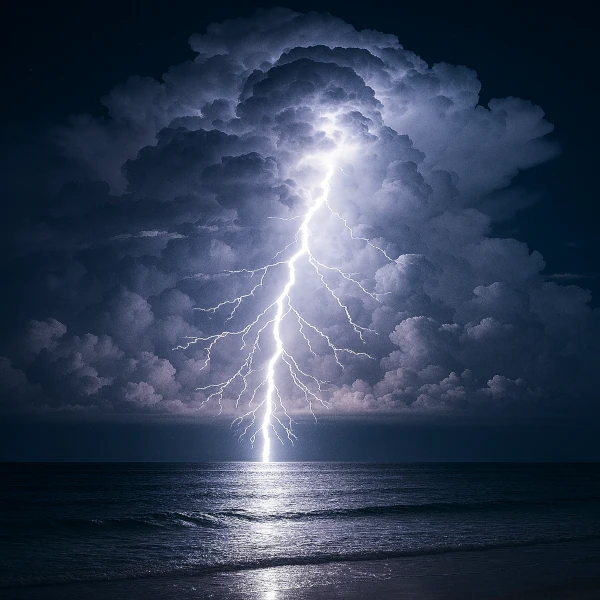
The term superbolt (or super-lightning) refers to a rare and extremely energetic category of lightning observed in Earth's atmosphere. A superbolt is an atmospheric electrical phenomenon characterized by a discharge a thousand times more intense than a classic lightning bolt. Their brightness is such that they can be observed from space by weather satellites. While a classic lightning bolt releases about 1 gigajoule of energy, superbolts can reach energies exceeding 100 gigajoules, making them 100 to 1000 times more powerful than ordinary lightning.
These exceptional meteorological phenomena were first identified in the 1970s by physicist Bernard Vonnegut (1914-1997), but it was only with modern satellites that their systematic study became possible.
| Physical parameter | Classic lightning | Superbolt | Ratio or remark |
|---|---|---|---|
| Light energy emitted | ≈ \(10^8\ \text{J}\) | ≈ \(10^{11}\ \text{J}\) | About 1000 times more intense |
| Duration of discharge | \(10^{-4}\ \text{s}\) (≈ 100 µs) | 1 to 10 × \(10^{-3}\ \text{s}\) | Duration 10 to 100 times longer |
| Maximum current | ≈ 30,000 A | 200,000 to 500,000 A | Up to 15 times higher |
| Temperature of the ionized channel | 20,000 to 30,000 °C | 30,000 to 50,000 °C | Hotter and more stable plasma |
| Local electric field | \(E \approx 10^5\ \text{V/m}\) | \(E \approx 10^6\ \text{V/m}\) | 10 times stronger electric field |
| Duration of channel ionization | A few microseconds | Up to several milliseconds | Almost continuous ionization |
| Average altitude of occurrence | 5 to 10 km | 10 to 15 km (cloud tops) | Cold and unstable regions |
Source: Holzworth et al., *Geophysical Research Letters*, 2020 – satellite data from OTD and LIS.
The genesis of a superbolt results from a rare combination of atmospheric conditions (electrostatic, thermodynamic, and particle-scale physical) within cumulonimbus clouds. These phenomena occur when a charge imbalance reaches a critical threshold, making possible a self-sustaining discharge of colossal energy. These conditions are only met in less than 0.01% of storms observed on a planetary scale.
In a storm cloud, ice crystals, graupel, and supercooled water droplets constantly collide. During these collisions, a small transfer of electrons occurs, most often from graupel to ice crystals. This multitude of exchanges eventually creates a natural battery: the upper part of the cloud becomes positive, while its central zone accumulates negative charges. The electric field thus generated can reach considerable values, on the order of \(E \approx 10^5 - 10^6\ \text{V/m}\).
This electric field eventually exceeds the dielectric strength of air (\(3 \times 10^6\ \text{V/m}\)), i.e., the limit beyond which air ceases to be an insulator. At this point, a partially ionized channel progresses in successive small steps, each locally reinforcing the electric field around it.
When the field reaches extreme values, exceeding \(10^6\ \text{V/m}\), free electrons are accelerated to speeds close to that of light. They then enter a relativistic electron avalanche, a process called RREA. This mechanism converts part of the electrostatic field's energy into a gigantic electric current. The ionized channel heats up abruptly, reaching temperatures of tens of thousands of degrees: the air expands violently and produces a luminous and sonic shock wave, the superbolt.
Superbolts mainly appear above oceans, where the conductivity of humid air favors extreme discharges, but they can also occur on continents, where charge gradients between cloud layers reach critical values. Observations indicate a potential difference reaching several gigavolts.
| Key factor | Mechanism | Impact on power | Favorable conditions |
|---|---|---|---|
| Cloud height | Greater distance between charge centers = increased potential difference | Increase in available potential energy for discharge | Cumulonimbus with great vertical extent (> 12 km) |
| Intensity of the electric field | Electric field significantly exceeding the dielectric strength of air | More efficient electron acceleration and amplification of the RREA phenomenon | Exceptional concentration of charges in the cloud |
| Duration of discharge | Prolonged charge transfer in the ionized channel | Greater temporal integration of current | Exceptional stability of the lightning channel |
| Relativistic advancement (RREA) | Avalanche of electrons reaching relativistic speeds | Exponential multiplication of charge carriers | Extreme electric fields (> 10^6 V/m) |
| Geometry of discharge | Discharge extending over greater horizontal or vertical distances | Larger volume of ionized air and increased charge transfer | Large-scale storms |
| Atmospheric conditions | Cold, dry air at altitude favoring charge accumulation | Reduction of leaks and improved insulation | Unstable air masses with strong thermal gradient |